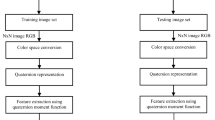Abstract
This article proposes a new quaternion-based method for rotation invariant color texture classification under illumination variance with respect to direction and spectral band. The color of an object varies according to the spectral power distribution, object-illumination, and viewing geometry of the light source. The quaternion representation of color is shown to be effective, which treats color channels as single unit rather than separate components. New texture signatures are extracted by calculating the norm of the Quaternion fourier spectrum. These signatures are proved to be invariant under image rotation and illumination rotation. Moreover, these features are also invariant to the color spaces. The robustness of different color spaces against varying illumination in color Texture classification with 45 samples of 15 outex texture classes are examined. Comparative results show that the proposed method is efficient in rotation invariant texture classification.











Similar content being viewed by others
References
Arvis V, Debain C, Berducat M, Benassi A (2004) Generalization of the co occurence matrix of color images: application to color texture classification. Image Anal Stereol 23:63–67
Davis LS, Johns SA, Aggarwal JK (1979) Texture analysis using generalized co-occurrence matrices. IEEE Trans Pattern Anal Machine Intell PAMI-1:251–259
Serra J, Wong AKC (1973) Mathematical morphology applied to fibre composite materials. Film Sci Technol 6:141–158
Mallat S (1989) A theory for multiresolution signal decomposition: the wavelet representation. IEEE Trans Pattern Recog Machine Intell 11(7):674–693
Idrissa M, Acheroy M (2002) Texture classification using Gabor filters. Pattern Recogn Lett 23(9):1095–1102
Arivazhagan S, Ganesan bL, Padam SP (2006) Texture classification using Gabor wavelets based rotation invariant features. Pattern Recogn Lett 27:1976–1982
Kashyap RL, Khotanzed A (1986) A model based method for rotation invariant texture classification. IEEE Trans Pattern Anal Machine Intell PAMI-8(4):472–481
Chantler M, Schmidt M, Petrou M, McGunnigle G (2002) The effect of illuminant rotation on texture filters: Lissajous’s ellipses. Proc Eur Conf Comput Vision 3:289–303
Vertan C, Boujemaa N (2000) Color texture classification by normalized color space representation. In: 15th International conference on pattern recognition (ICPR’00), vol 3, Barcelona, pp 35–84
Petrou M, García SPG (2006) Image processing. Dealing with texture, Wiley Interscience, Petrou, TA1637, P48
Haralick RM, Shanmugam K, Dinstein I (1973) Textural features for image classification. IEEE Trans Systems, Man Cybernet 3:610–621
Palm C (2004) Color texture classification by integrative co-occurrence matrices. Pattern Recogn 37:965–976
Sertel O, Lozanski G, Shana’ah A, Catalyurek U, Saltz J, Gurcan S (2008) Texture classification using nonlinear color quantization: application to histopathological image analysis. In: Proceedings of IEEE international conference on acoustics, speech and image processing, Las Vegas, pp 597–600
Bianconi F, Fernández A, Gonzalez E, Caride D, Calvino A (2009) Rotation-invariant colour texture classification through multilayer CCR. Elsevier, New York, Pattern Recognition Letters 30: 765–773
van de Sande KEA, Gevers T, Snoek GM (2010) Evaluating color descriptors for object and scene recognition. IEEE Trans Pattern Anal Mach intll 32:1582–1596
Bülow T, Sommer G (2001) Hypercomplex signals—a novel extension of the analytic signal to the multidimensional case. IEEE Trans Signal Proc 49(11):2844–2852
Kakumanu P, Makrogiannis S, Bourbakis N (2007) A survey of skin-color modeling and detection methods. Pattern Recogn 40(3):1106–1122
Kauppinen H, Silvén O (1996) The effect of illumination variations on color-based wood defect classification. In: 13th ICPR, Vienna, pp 828–832
Hamilton WR (1844) On Quaternions; or a new system of imaginaries in algebra. Philos Mag 25:489–1844
Sangwine SJ, Ell TA (1999) Hypercomplex auto and cross correlation of color images. In: IEEE international conference on image processing (ICIP’99), Kobe, pp 319–322
Evans CJ, Ell TA, Sangwine SJ (2000) Hyper complex color sensitive smoothing filters, vol 1. ICIP Vancouver, Canada, pp 541–544
Sangwine SJ, Evans CJ, Ell TA (2000) Color sensitive edge detection using hyper complex filters. In: Proceedings of the tenth European signal processing conference (EUSIPCO), vol I. Tampere, Finland, pp 107–110
Sangwine SJ, Evans CJ, Ell TA (2001) Hyper complex fourier transforms of color images. In: Proceedings of the IEEE international conference on image processing (ICIP 2001), vol I. Thessaloniki, Greece, pp 137–140
Shi L, Funt B (2005) Quaternion color texture, AIC′2005 proceedings of the tenth congress of the international color association, Granada
Sangwine SJ (1996) Fourier transform of color images using quaternion, or hypercomplex, numbers. Electron Lett 32(21):1979–1980
Ell TA, Sangwine SJ (2007) Hypercomplex fourier transforms of color images. IEEE Trans Image Proc 16(1):22–35
P-Ukomoto M, Ueda K, Takahashi S -I (1995) Realization of four real coefficient transfer functions by one hypercomplex transfer function. In: Proceedings of 12th European conference circuit theory and design (ECCTD’95), ITLJ, Istanbul Technical University, Istanbul, pp 975–978
Pei S-C, Ding J-J, Chang J-H (2001) Efficient implementation of quaternion fourier transform, convolution, and correlation by 2-D complex FFT. IEEE Trans Signal Proc 49(11):2783–2797
Hu M (1962) Visual pattern recognition by moment invariants. IRE Trans Inform Theory 8:179–187
Acknowledgment
The authors are very much thankful to the reviewers for their valuable comments and also to the Management and Department of Electronics and Communication Engineering of Thiagarajar College of Engineering for their support and assistance to carry out this work.
Author information
Authors and Affiliations
Corresponding author
Electronic supplementary material
Below is the link to the electronic supplementary material.
Rights and permissions
About this article
Cite this article
Sathyabama, B., Anitha, M., Raju, S. et al. Rotation invariant features for color texture classification and retrieval under varying illumination. Pattern Anal Applic 16, 69–81 (2013). https://doi.org/10.1007/s10044-011-0207-0
Received:
Accepted:
Published:
Issue Date:
DOI: https://doi.org/10.1007/s10044-011-0207-0




